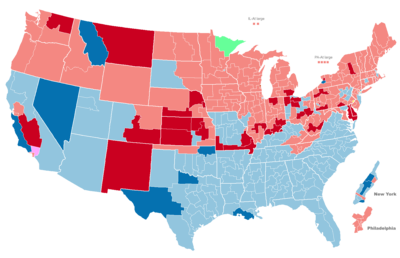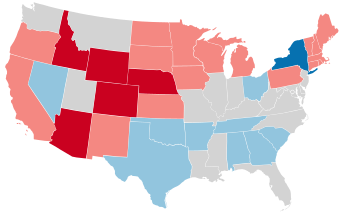1918 United States elections
| ← 1916 1917 1918 1919 1920 → Midterm elections | |
| Election day | November 5 |
|---|---|
| Incumbent president | Woodrow Wilson (Democratic) |
| Next Congress | 66th |
| Senate elections | |
| Overall control | Republican gain |
| Seats contested | 38 of 96 seats (32 Class 2 seats + 9 special elections)[1] |
| Net seat change | Republican +6[2] |
 | |
| 1918 Senate election results
Democratic gain Democratic hold | |
| House elections | |
| Overall control | Republican gain |
| Seats contested | All 435 voting seats |
| Net seat change | Republican +24 |
 | |
| 1918 House of Representatives results | |
| Gubernatorial elections | |
| Seats contested | 32 |
| Net seat change | Republican +4 |
 | |
| 1918 gubernatorial election results
Democratic gain Democratic hold | |
The 1918 United States elections elected the 66th United States Congress, and took place in the middle of Democratic President Woodrow Wilson's second term. The election was held during the Fourth Party System. It was the lone election to take place during America's involvement in World War I. Republicans won control of both chambers of Congress for the first time since the 1908 election.
The election took place during the Spanish flu pandemic. Campaigning was disrupted around the country. In Nebraska, for instance, authorities lifted a ban on public gatherings in early November 1918 and permitted politicians to campaign five days prior to polls opening. The turnout was 40%, which was unusually low for a midterm election (turnout was at 52% and 50% in the 1910 and 1914 midterm elections). The low turnout was possibly due to the disruption caused by the pandemic.[3][4]
In an example of the six-year itch phenomenon, Republicans took complete control of Congress from the Democrats. The Republicans won large gains in the House, taking 25 seats and ending coalition control of the chamber.[5] In the Senate, Republicans gained 5 seats, taking control of the chamber by a slim majority.[6]
The elections were a major defeat for progressives and Wilson's foreign policy agenda, and foreshadowed the Republican victory in the 1920 election. Republicans ran against the expanded wartime government and the Fourteen Points, especially Wilson's proposal for the League of Nations. The Republican victory left them in control of both houses of Congress until the 1930 election.[7]
State ballot initiatives
[edit]Women's suffrage
[edit]The election was also a turning point for women's suffrage in the United States: ballot initiatives to extend suffrage to women (among all-male electorates) were held in the states of Oklahoma, Louisiana, South Dakota, and Michigan. Of these initiatives, all but the one in Louisiana passed, and despite the ongoing pandemic, extensive grassroots organizing by suffragists [8] meant they successfully campaigned against incumbent Senators who had refused to support the Nineteenth Amendment to the United States Constitution, including John W. Weeks of Massachusetts, who had been considered invincible, and Willard Saulsbury Jr. of Delaware.
Prohibition
[edit]A number of state level ballot initiatives were also held regarding prohibition with some banning outright while others banned it in certain cases. California held two simultaneously with the two failing with one proposing it be banned in bars/saloons while the other proposed banning the sale, manufacturing and purchasing of alcohol in California.[9][10] The Washington measure which passed had an exemption to prohibition if alcohol was being used for religious purposes.[11]
| State | Status |
|---|---|
| California | Failed[9] |
| Colorado | Passed[12] |
| Florida | Passed[13] |
| Minnesota | Failed[14] |
| Missouri | Failed[15] |
| Nevada | Passed[16] |
| Ohio | Passed[17] |
| Washington | Passed[11] |
See also
[edit]- 1918 United States House of Representatives elections
- 1918 United States Senate elections
- 1918 United States gubernatorial elections
- Presidency of Woodrow Wilson
References
[edit]- ^ Three Class 2 seats held both a regularly-scheduled election and a special election in 1918. These seats are not double-counted for the total number of seats contested.
- ^ Republicans picked up four seats in the regularly-scheduled elections and gained an additional two seats in the special elections.
- ^ Searcey, Dionne (March 21, 2020). "The Lessons of the Elections of 1918". The New York Times. ISSN 0362-4331. Retrieved March 21, 2020.
- ^ "Here's How Coronavirus Is Affecting Voter Turnout". Time. March 6, 2020. Retrieved March 21, 2020.
- ^ "Party Divisions of the House of Representatives". United States House of Representatives. Retrieved June 25, 2014.
- ^ "Party Division in the Senate, 1789-Present". United States Senate. Retrieved June 25, 2014.
- ^ Busch, Andrew (1999). Horses in Midstream. University of Pittsburgh Press. pp. 87–91.
- ^ DuBois, Ellen Carol (April 20, 2020). "A pandemic nearly derailed the women's suffrage movement". National Geographic. Archived from the original on April 21, 2020. Retrieved April 27, 2020.
- ^ a b "California Proposition 22, Alcohol Prohibition Initiative (1918)". Ballotpeida. Retrieved December 31, 2024.
- ^ "California Proposition 1, Drinking Saloons Prohibition Initiative (1918)". Ballotpedia. Retrieved December 31, 2024.
- ^ a b "Washington Referendum 10, Alcohol Prohibition Measure (1918)". Ballotpedia. Retrieved December 31, 2024.
- ^ "Colorado "Bone Dry" Prohibition, Measure 3 (1918)". Ballotpedia. Retrieved December 31, 2024.
- ^ "Florida Alcohol Prohibition Amendment (1918)". Ballotpedia. Retrieved December 31, 2024.
- ^ "Minnesota Prohibit Alcohol, Amendment 1 (1918)". Ballotpedia. Retrieved December 31, 2024.
- ^ "Missouri Prohibiting Intoxicating Liquors, Issue 6 (1918)". Ballotpedia. Retrieved December 31, 2024.
- ^ "Nevada Statewide Prohibition (1918)". Ballotpedia. Retrieved December 31, 2024.
- ^ "Ohio Alcohol Prohibition Initiative (1918)". Ballotpedia. Retrieved December 31, 2024.
Further reading
[edit]- Dewitt, Howard A. "Charles L. McNary and the 1918 Congressional Election." Oregon Historical Quarterly 68.2 (1967): 125-140. online
- Jenson, Carol. "Loyalty as a Political Weapon: The 1918 Campaign in Minnesota." Minnesota History 43.2 (1972): 42-57. online
- Livermore, Seward W. "The sectional issue in the 1918 congressional elections." Mississippi Valley Historical Review 35.1 (1948): 29-60. online
- Lowitt, Richard. "Senator Norris and His 1918 Campaign." Pacific Northwest Quarterly 57.3 (1966): 113-119. in Nebraska.
